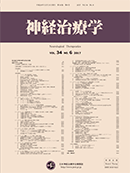Volume 34, Issue 1
Displaying 1-17 of 17 articles from this issue
- |<
- <
- 1
- >
- >|
-
2017 Volume 34 Issue 1 Pages 1
Published: 2017
Released on J-STAGE: May 31, 2017
Download PDF (213K)
-
2017 Volume 34 Issue 1 Pages 3-7
Published: 2017
Released on J-STAGE: May 31, 2017
Download PDF (442K)
-
2017 Volume 34 Issue 1 Pages 8
Published: 2017
Released on J-STAGE: May 31, 2017
Download PDF (219K) -
2017 Volume 34 Issue 1 Pages 9-12
Published: 2017
Released on J-STAGE: May 31, 2017
Download PDF (947K) -
2017 Volume 34 Issue 1 Pages 13-17
Published: 2017
Released on J-STAGE: May 31, 2017
Download PDF (1138K) -
2017 Volume 34 Issue 1 Pages 18-23
Published: 2017
Released on J-STAGE: May 31, 2017
Download PDF (981K) -
2017 Volume 34 Issue 1 Pages 24-30
Published: 2017
Released on J-STAGE: May 31, 2017
Download PDF (1475K) -
2017 Volume 34 Issue 1 Pages 31-36
Published: 2017
Released on J-STAGE: May 31, 2017
Download PDF (2990K)
-
2017 Volume 34 Issue 1 Pages 37-42
Published: 2017
Released on J-STAGE: May 31, 2017
Download PDF (809K) -
2017 Volume 34 Issue 1 Pages 43-46
Published: 2017
Released on J-STAGE: May 31, 2017
Download PDF (946K) -
2017 Volume 34 Issue 1 Pages 47-50
Published: 2017
Released on J-STAGE: May 31, 2017
Download PDF (1621K) -
2017 Volume 34 Issue 1 Pages 51-55
Published: 2017
Released on J-STAGE: May 31, 2017
Download PDF (838K)
-
2017 Volume 34 Issue 1 Pages 56-57
Published: 2017
Released on J-STAGE: May 31, 2017
Download PDF (1286K)
-
2017 Volume 34 Issue 1 Pages 58-61
Published: 2017
Released on J-STAGE: May 31, 2017
Download PDF (364K) -
2017 Volume 34 Issue 1 Pages 63
Published: 2017
Released on J-STAGE: May 31, 2017
Download PDF (205K) -
2017 Volume 34 Issue 1 Pages 64
Published: 2017
Released on J-STAGE: May 31, 2017
Download PDF (206K) -
2017 Volume 34 Issue 1 Pages I1
Published: 2017
Released on J-STAGE: May 31, 2017
Download PDF (120K)
- |<
- <
- 1
- >
- >|
